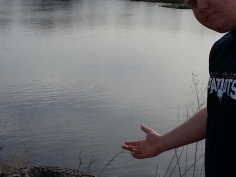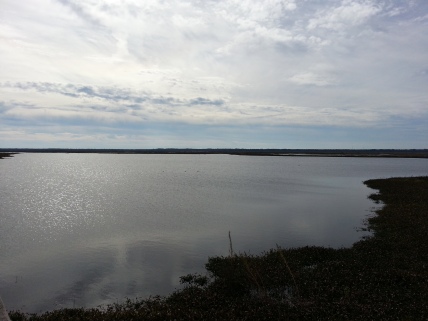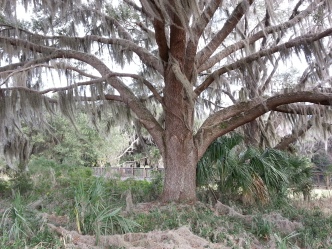I woke up this morning fully intent on attending church. Sundays are generally awkward because my husband has to work at random times, and I prefer to see him out the door before leaving myself. Today he left 15 minutes too late for me to attend the first service at my church. I was showered and dressed and ready well before second service, when my son suggested we go hiking.
It seems I so rarely see this 18-year-old despite living with him, and I usually am so task-oriented when I do see him that we haven’t taken the time to explore and enjoy together. The day was cool and clear and calling us to experience it fully. We chose to do so.
We packed a cooler with bottles of water and some oranges, changed into sneakers and jeans, and drove to the trail’s entrance. It had been at least ten years since we’d done this particular trail — and much had changed, namely the numbers of people also walking and the addition of some sidewalks and boardwalks. Even at 10 in the morning, the meager parking lot associated with the Paynes Prairie state park was nearing fullness. We simply followed the scattering of people down the sidewalk, noting the changes more than the natural beauty and wondering if we were, indeed, at the right place. All signs — brown, metal, state park official — indicated that we were. But our senses told us differently.
Of course, this prairie had once been the site of the state’s largest cattle ranch, the host of numerous battles in the Seminole War (a slightly different war now annually hosted the Saturday after Thanksgiving on the football field, Gators vs. Seminoles), and for 20 years a lake traversed by steamboats carrying people and lumber and supplies after a flood clogged the prairie’s basin. Should I be surprised that its form has varied since my last visit there a decade ago?
Instead of my old, bulky camera, my son and I both carried our cell phones, with no intentions of using them except to capture images of the day. (Well, I had no other intentions, but Adam immediately published his photos via Instagram and enjoyed the startled responses of his friends.) The little boy from 10 years ago was now a young man, towering over my tall self.
In earlier days, we had been used to visiting a ranger station, complete with a guest book in which visitors recorded the number of alligators they’d seen that day. We then would walk down a hill, exiting the woods of hundreds-year-old mossy oaks and veering to the left to enter a sunny, wild prairie with its scattered bodies of water and scant, if any, other inhabitants of the human kind. Those we did meet were fellow lovers of nature, quietly walking the matted grass paths to earn a view of whatever wildlife we happened upon. We wondered if we would see the bison and wild horses that trip. The sandhill cranes? The alligators? And how many of those would we record seeing upon returning to the visitor center?
Now that welcome center was no longer evident, and the paved sidewalk merely escorted us through a horse stable with signs warning that this was not a zoo or a theme park. That animals are wild, not trained. To stay 20 feet from alligators on land. Ten feet in the water. (Who was braving those alligator-infested waters — ever? And can’t alligators move much faster in water than on land?) At first, it seemed our choice to come would be disappointing, but the sidewalk ended into a long boardwalk that ended in the grass path that revived the old thrill of being in the great Florida outdoors.
It didn’t take long before the familiar path led us to the water, where the alligators slept laconically on the near and far banks, their prehistoric armor appearing out of place amid the sea grasses and light-hearted birds drying their outstretched wings. The too many photographers on the shore pointed out the native prairie life by focusing their long lenses atop tripods. Click, click, click, click, click. I tried to squeeze into position to click my own camera but only could focus on the wildlife with my sunglasses-protected eyes; I could see nothing on my smartphone screen to adequately frame a photo. So I merely pointed my Samsung toward the scene and shot, listening for the tell-tale sounds that indicated camera action, and hoped I had managed to capture the moment digitally.
In the end, I walked and talked and listened and looked, enjoying the moment rather than attempting to record it with my blind photos. The trail was much like what we remembered and yet so different. The prairie had more water, the trail less wide, with water edging so close on either side that the grassy path gave way to mud. It was impossible to keep 20 feet between ourselves and the alligators, but we weren’t afraid. The upside to the larger crowds was the “safety in numbers” concept. The human population was testimony that the route was safe enough.
As we made our way back to our vehicle, we saw lines of cars making their way to the trail head, a steady stream that made us glad we’d arrived and were leaving when we did. A car signaled to indicate it was waiting for our space, and so we left. Fondly remembering the past, glad to have taken the time to create a new memory, and considering other trails and natural spots — ones less popular, we hoped — that we could visit in the future together. Altogether — and for once together — not a bad way to spend a Sunday morning.












